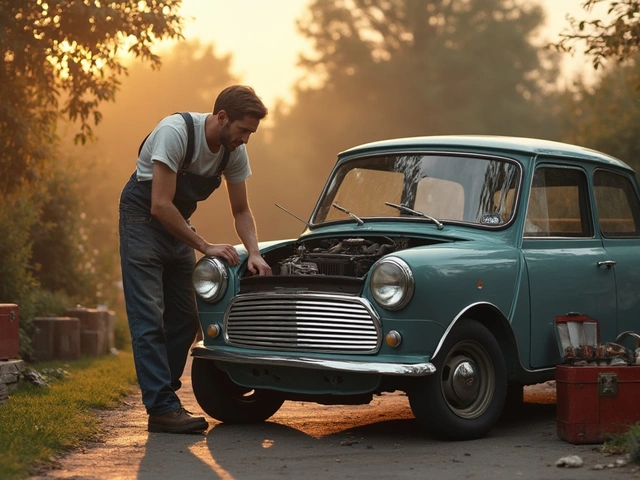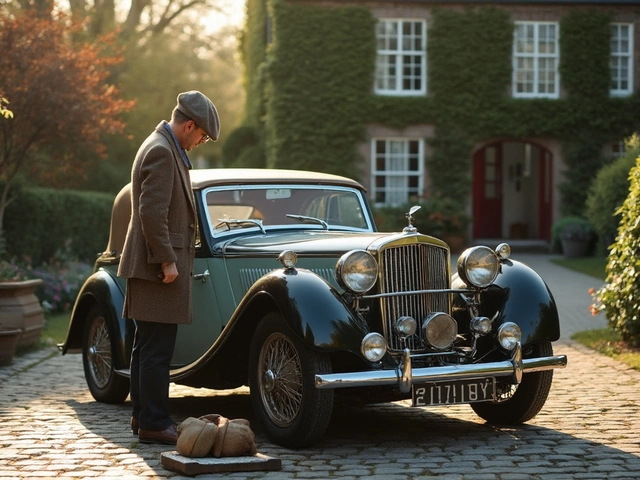When your brakes start acting up, ignoring it is like ignoring a weird lump in your sock—something’s bound to get worse. Most folks aren’t sure if the issue is the brake pads or the rotors, but this isn’t rocket science. In fact, your car drops plenty of hints before it goes from annoying to downright dangerous.
If you’re hearing screeching, grinding, or even a random thump, don’t just turn up the radio and hope it goes away. That sound is your first warning—sometimes it’s just the pads, other times it’s the rotors telling you they’ve had enough. Maybe your steering wheel trembles every time you slow down, or the whole car jerks when you brake. These are all red flags that shouldn't be ignored.
You don’t need to be a mechanic to catch some visual cues, either. With just a flashlight, you can peek through the spokes on your wheels and spot some obvious stuff—like pads worn thin as a dime or rotors that look grooved like an old vinyl record. Catching these signs early saves you cash and keeps you from an unplanned roadside adventure.
- Strange Noises: The Dead Giveaway
- How Your Car Feels and Handles
- Visual Clues: What to Look For
- Comparing Pad vs Rotor Problems
- Easy Checks You Can Do at Home
Strange Noises: The Dead Giveaway
Your car won’t whisper when it needs new brake pads or fresh rotors—it’ll shout. Noises are usually the first hint that something’s up with your brakes. And these sounds aren’t just random; they each point to different problems.
The high-pitched squeal you sometimes hear when braking is a classic signal. Most modern brake pads have a tiny metal tab called a wear indicator. When the pads get thin, that tab scrapes against the rotor and makes a squealing sound. This is your heads-up: swap those pads soon. If you ignore it, the noise will get worse, and fixing your brakes will cost way more.
Grinding is another story. If your brakes sound like metal on metal, the pads are probably shot and now you’re chewing into your rotors. That’s both dangerous and expensive, since now you’ll need both new pads and rotors. No one wants that bill.
Sometimes you’ll catch a low-pitched rumble or growling noise. That usually means the rotor surface is uneven or warped. Warped rotors don’t just sound ugly—they mess with your stopping power and can make the entire car feel shaky.
- Squealing: Thin pads, wear indicator doing its job.
- Grinding: Bare metal-on-metal contact—pad’s gone, rotors getting ruined.
- Clicking or rattling: Pads loose in the caliper, worn hardware, or missing clips. Worth a check.
- Thumping: Rotor unevenness or cracked rotors.
Wonder how common these noises are? Here’s a quick look at what people usually report to their mechanics:
| Noise Type | Most Likely Cause | Frequency (in reported cases) |
|---|---|---|
| Squealing | Wear indicator or dust buildup | 60% |
| Grinding | Worn-out pads, damaged rotors | 25% |
| Thumping | Warped or cracked rotors | 10% |
| Clicking | Loose hardware, worn pads | 5% |
If your car is making any of these sounds, don’t brush it off. Getting an early diagnosis could save your wallet and—more importantly—your safety. Always take noises seriously when it comes to brakes.
How Your Car Feels and Handles
If your car feels weird when you hit the brakes, that’s your first clue something’s up. Your ride should slow down smoothly, without any drama. When things don’t feel right, it’s usually a sign that either your brake pads or rotors (or both) need attention.
Here's what to keep an eye out for:
- Pulsing or vibrating brake pedal: If your brake pedal shudders or pulses when you stop, that’s usually from warped rotors. Picture it like running your hand along a bumpy road—the uneven surface makes the whole thing shake.
- Steering wheel shakes: If your steering wheel wiggles when braking, you’re probably dealing with uneven rotor surfaces.
- Car pulling to one side: When pressing the brakes, if your car drifts left or right, it could be from uneven pad wear or a stuck caliper. Either way, it's warning you of something not wearing evenly.
- Soft or mushy pedal: If your pedal sinks easily or feels spongy, your brake pads are likely worn thin or there might be air in the brake lines. That’s not something you want to shrug off.
Don’t forget: How your car responds can change based on your speed. Vibrations at higher speeds almost always point to rotor issues, while most noisy stops at low speeds lean more toward worn-out pads.
| Symptom | Likely Cause |
|---|---|
| Pulsing Brake Pedal | Warped Rotors |
| Steering Wheel Shake | Uneven or damaged Rotors |
| Pulling to Side | Uneven Pad Wear, Stuck Caliper |
| Soft Pedal | Worn Pads, Air in Lines |
| Grinding Noise | Pads Worn Through |
Regularly noticing any of these signs? Don’t wait—bad brakes put you and everyone else at risk. Grab a flashlight, check your brakes, and call your shop if things just feel...off. Taking five minutes could save you hundreds—or worse, an accident. And next time you're chatting car stuff, drop the word brake pads and sound like a pro.

Visual Clues: What to Look For
Spotting worn brake pads or bad rotors can save you headaches (and cash) down the road. A quick look through your rims might tell you more than you’d expect. If you don’t have fancy tools, grab a flashlight and kneel down by your wheel—this basic check works for most cars.
For brake pads, you’re looking for the thickness. Most new pads are about 10-12 mm thick. If they’re getting close to 3 mm or less, it’s time to swap them out. Pads also have a little metal tab, a wear indicator, that squeals when it rubs against the rotor. If you can barely see pad material or it looks uneven, that’s a problem.
Rotors are a bit trickier, but here’s what to look for:
- Deep grooves or ridges, like a vinyl record. Smooth rotors are good, rough or scored ones need help.
- Blue discoloration—that means your rotors got really hot, maybe from riding the brakes or a stuck caliper.
- Cracks, especially small hairline ones near the edges, which are bad news for safety.
- Rusty patches. A little surface rust is normal after rain, but thick, flaky rust isn’t.
Here’s a quick look at what you might find versus what’s healthy:
| Part | What’s Normal | What’s Bad |
|---|---|---|
| Brake Pads | 10-12 mm thick, even wear | <3 mm thick, uneven or missing pad |
| Rotors | Clean, smooth surface | Deep grooves, blue-hot spots, cracks, chunky rust |
You can spot most of this without taking your wheel off. If you see anything that screams trouble, don’t wait—a cheap fix now beats paying for a full brake job later.
Comparing Pad vs Rotor Problems
The biggest struggle? Figuring out if you’re dealing with shot brake pads or beat-up rotors. They both make your car stop badly, but the symptoms are a little different. If you listen and pay attention, you’ll soon know which one’s crying for help.
- If your brakes squeal or squeak every time you hit the pedal, that’s brake pads almost every time. Most pads actually come with a built-in metal tab that starts rubbing when they get thin, basically yelling at you to get them changed.
- If you hear grinding—like metal dragging on a sidewalk—it usually means your pads are completely gone, and now you’re chewing into your rotors. If you catch it late and that grinding sound shows up, you’ll probably have to replace both the pads and rotors.
- Vibrations or the steering wheel shaking as you brake are classic signs your rotors are warped. This happens from a ton of heat over time, like after lots of hard stops or towing heavy stuff. Warped rotors can also give the brake pedal a weird pulse, almost as if it’s pushing back against your foot.
Pads wear out faster than rotors, with most people replacing them every 30,000 to 50,000 miles, depending on driving style. Rotors, if you’re lucky, can make it to 70,000 miles, but hard braking and skipping pad changes will take them out faster.
| Symptom | Likely Culprit |
|---|---|
| Squealing sound | Brake pads |
| Grinding noise | Pads (or already damaging rotors) |
| Vibration in pedal or steering | Rotors |
| Longer stopping distance | Both (more likely pads) |
| Visible grooves | Rotors |
A quick tip: if your brake pads are wearing out sooner than expected, check if your calipers are sticking or if you’re using super cheap pads. Cheap out here, and you’ll pay more fixing rotors later. If your rotors look blue or have deep grooves, swap them before they chew through another set of pads.

Easy Checks You Can Do at Home
You don’t need a garage full of tools or a mechanic’s license to keep tabs on your brake pads and rotors. A handful of simple checks can clue you in on what’s worn out and what’s still good to go. Here are a few practical things you can do in your own driveway:
- Listen Up: Roll down your windows and brake. Hear a squeal or grinding? Squealing often means your pads are worn thin, while grinding is a big warning that the pads may be gone and you’re chewing up the rotors.
- Peek Through the Wheels: Look through the holes in your rim. Good pads should be thicker than a nickel (about 3mm or more). If they're thinner, it's time for replacements.
- Check the Brake Dust: Usually, a normal amount of black dust on your wheels is a good sign—your pads are doing their job. If you notice way more or almost none, it could mean uneven wear or that your pads are shot.
- Touch the Rotor (When Cold): With the wheel off and the car safely resting on jack stands, look at and gently feel the rotor surface. If it's grooved, heavily scored, or feels wavy, that's trouble.
- Brake Pedal Feel: If your pedal suddenly feels soft or you have to push it down farther than usual, that's a hint something's off. Could be pads, rotors, or even a fluid issue.
Here’s a quick look at typical lifespan and warning signs for pads and rotors:
| Part | Average Lifespan (Miles) | Warning Signs |
|---|---|---|
| Brake Pads | 30,000 - 70,000 | Squealing, thin friction material |
| Rotors | 50,000 - 70,000 | Grinding, pulsing pedal, deep grooves |
Don’t forget: catch these signs early and you can swap pads before rotors get trashed, saving hundreds. And if you’re not sure, snap a photo and show your local parts store or mechanic—no shame in double-checking before you spend money or time.


